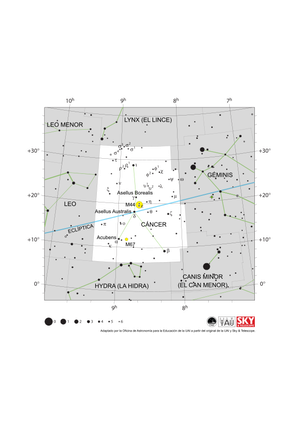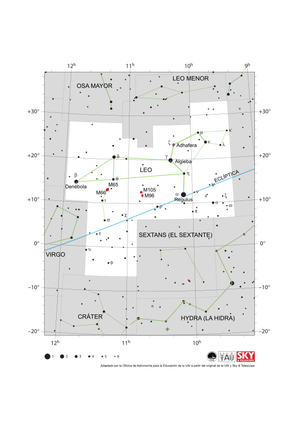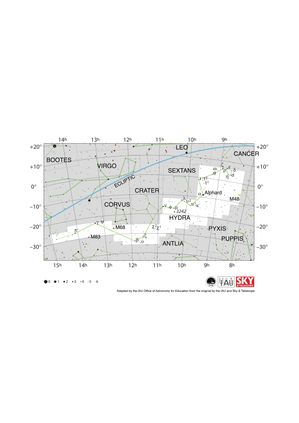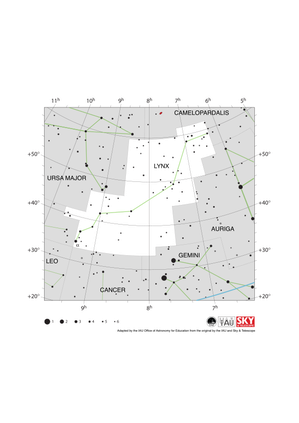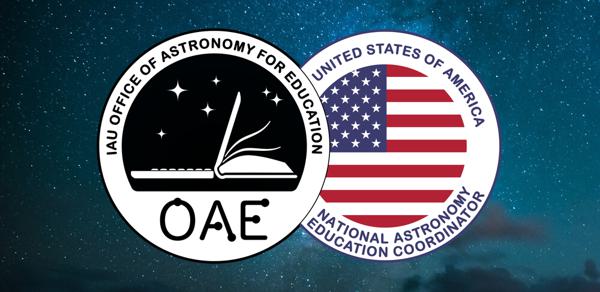Glossary term: Cáncer
Description: Cáncer es una de las constelaciones del Zodíaco, es decir, las estrellas que forman esta constelación se encuentran en la parte del cielo que se cruza con la eclíptica (el plano definido por la trayectoria de la Tierra alrededor del Sol). Por lo tanto, desde la Tierra, podemos encontrar regularmente al Sol, y también planetas, en la constelación de Cáncer. En el caso del Sol, esto ocurre desde finales de julio y principios de agosto (en esa época, por supuesto, no podemos ver las estrellas de la constelación). Hace dos mil años el Sol estaba en Cáncer durante el solsticio de verano del hemisferio norte, de ahí el nombre del Trópico de Cáncer. Debido a la precesión de los equinoccios, el Sol ya no se encuentra en Cáncer en el solsticio de verano del hemisferio norte. Cáncer es una de las 88 constelaciones modernas definidas por la Unión Astronómica Internacional, pero se remonta mucho más atrás: ya era una de las 48 constelaciones nombradas por el astrónomo del siglo II Claudio Ptolomeo.
Related Terms:
See this term in other languages
Term and definition status: The original definition of this term in English have been approved by a research astronomer and a teacher The translation of this term and its definition is still awaiting approval
The OAE Multilingual Glossary is a project of the IAU Office of Astronomy for Education (OAE) in collaboration with the IAU Office of Astronomy Outreach (OAO). The terms and definitions were chosen, written and reviewed by a collective effort from the OAE, the OAE Centers and Nodes, the OAE National Astronomy Education Coordinators (NAECs) and other volunteers. You can find a full list of credits here. All glossary terms and their definitions are released under a Creative Commons CC BY-4.0 license and should be credited to "IAU OAE".
If you notice a factual or translation error in this glossary term or definition then please get in touch.
Related Media
Most Brightest Stars of the Sky
Credit: Giorgia Hofer/IAU OAE
License: CC-BY-4.0 Creative Commons Reconocimiento 4.0 Internacional (CC BY 4.0) icons
Related Diagrams
Mapa de la constelación de Cáncer
Credit: Adaptado por la Oficina de Astronomía para la Educación de la UAI a partir del original de UAI/Sky & Telescope
License: CC-BY-4.0 Creative Commons Reconocimiento 4.0 Internacional (CC BY 4.0) icons
Mapa de la constelación de Leo
Credit: Adaptado por la Oficina de Astronomía para la Educación de la UAI a partir del original de UAI/Sky & Telescope
License: CC-BY-4.0 Creative Commons Reconocimiento 4.0 Internacional (CC BY 4.0) icons
Hydra Constellation Map
Credit: Adapted by the IAU Office of Astronomy for Education from the original by the IAU and Sky & Telescope
License: CC-BY-4.0 Creative Commons Reconocimiento 4.0 Internacional (CC BY 4.0) icons
Lynx Constellation Map
Credit: Adapted by the IAU Office of Astronomy for Education from the original by the IAU and Sky & Telescope
License: CC-BY-4.0 Creative Commons Reconocimiento 4.0 Internacional (CC BY 4.0) icons

